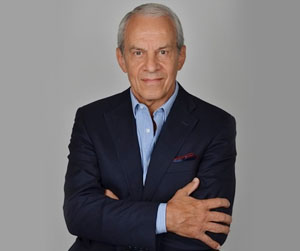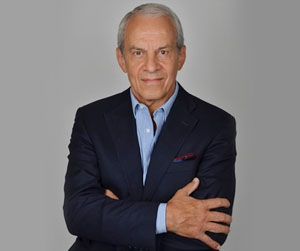Round Block - Benelli lift
Breast shape and size are very important for women’s psycho-social well-being and a fundamental part of the female psyche. The breasts are a powerful symbol of female identity.
Surgery to correct the appearance of the breasts can go a long way to achieving the physical and psychological harmony that no other medical treatment will restore.
One resolved complex should never create another: surgery should leave next to no trace, with the smallest, most discreet scarring possible.
Standard mammoplasties can often cause extensive scarring. To reduce this scarring I developed the “Round Block - Benelli lift” technique that leaves a single scar around the areola, an area that usually heals well and where scarring is barely visible as it merges with the outline of the areola due to the differences in colour and height between the areola and breast. There is no vertical scar under the areola or in the crease under the breast.
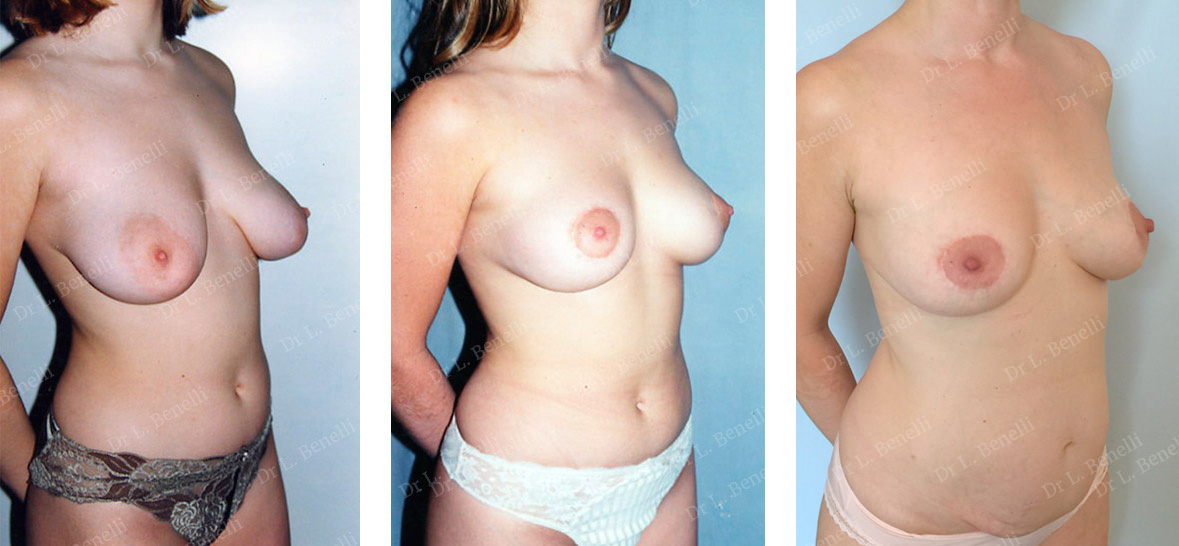
Ptosis correction with moderate volume reduction by Round Block - Benelli lift: Result after 1 year and after 18 years and 2 pregnancies with 6 months breastfeeding each
This Round Block technique-Benelli lift is particularly useful, when anatomically possible, for sagging breasts or hypertrophy.
Concept and technique
The concept of the Round Block - Benelli lift technique differs fundamentally from conventional techniques in the way the skin is used.
In conventional techniques with an extensive inverted T scar or vertical scar, the way in which the skin is cut determines the shape of the breast, hence the need to extend the scars if there is significant sagging.
The Round Block technique - Benelli lift uses the skin for its anatomical purpose, i.e. as a cover. The shape is not achieved by cutting the skin but by reshaping the mammary gland separately from the skin.
The sagging, drooping, flat gland is repositioned on the pectoral muscle above the crease under the breast and given a conical shape by arranging the gland specifically to the patient’s anatomy, separately from the skin, which is only cut around the areola.
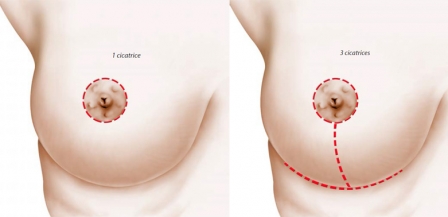
Periareolar unique scar by Round Block - Benelli lift technique versus 3 inverted T-shaped scars with the classical technique
The excess skin is removed around the areola and the remaining skin is evenly redraped over the new conical gland and around the areola using the Round Block - Benelli lift technique. To prevent the areola from expanding or becoming deformed, which was the major drawback of the former periareolar techniques, a deep periareolar encircling thread is inserted to control the areola’s diameter in the long term and adapt the skin around the areola, leaving a single circular periareolar scar.
Redraping the excess skin around the areola can initially cause different degrees of creasing around the areola, depending on the amount of skin removed. These creases disappear completely within a few weeks or months.
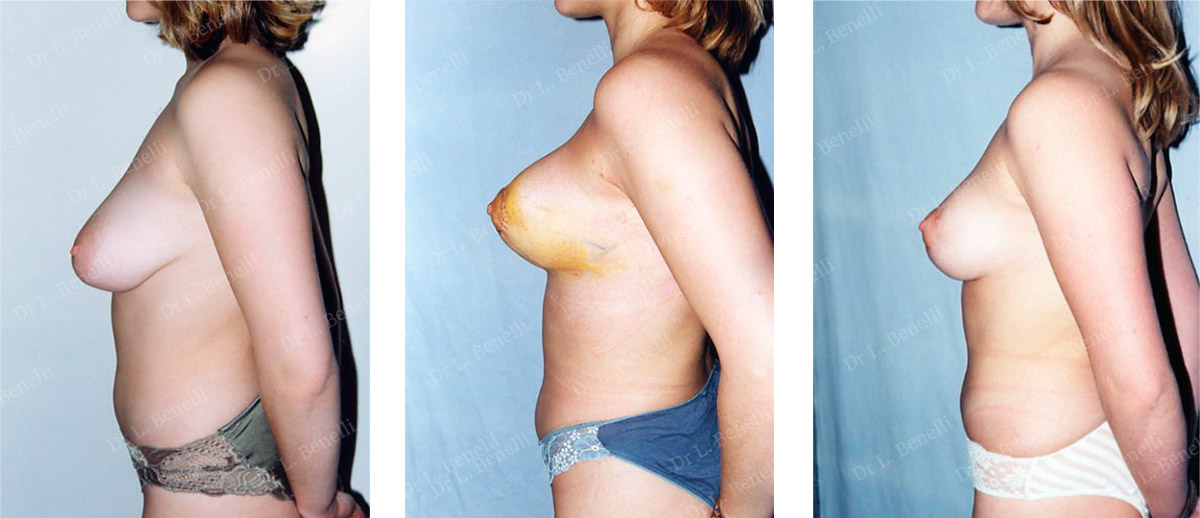
Same patient side view. Result after 1 week. Breast projection will return to a natural position after the post-operative deflation. Result after 1 year.
As with conventional techniques, the nipple and areola remain completely attached to the gland, making lactation possible after pregnancy.
If the gland is too small to produce a sufficiently curved cone, it may be advisable to simultaneously insert a breast prosthesis, and the sagging skin will still be tightened by the single Round Block - Benelli lift scar around the areola.
Indications
To correct ptosis (breast sagging) and hypertrophy, the Round Block - Benelli lift technique is especially suitable for patients whose scars are not expected to heal well. When this is the case it is important to minimize scarring, particularly in the periareolar circle where the skin usually scars well. The skin around the areola is thin and supple, designed by nature to change in size during pregnancy and breastfeeding, while the skin on the crease under the breasts is firmer to support the breasts and usually produces thicker scarring than around the areola.

Areola aspect, same patient - Résult after 1 month showing periareolar small pleats will progressively phase out - Results after 1 year standing and lying position. See the natural aspect of the breast base preserved from scar
In cases of very extensive hypertrophy and ptosis, the Round Block - Benelli lift technique can only be used if the gland and skin are firm.
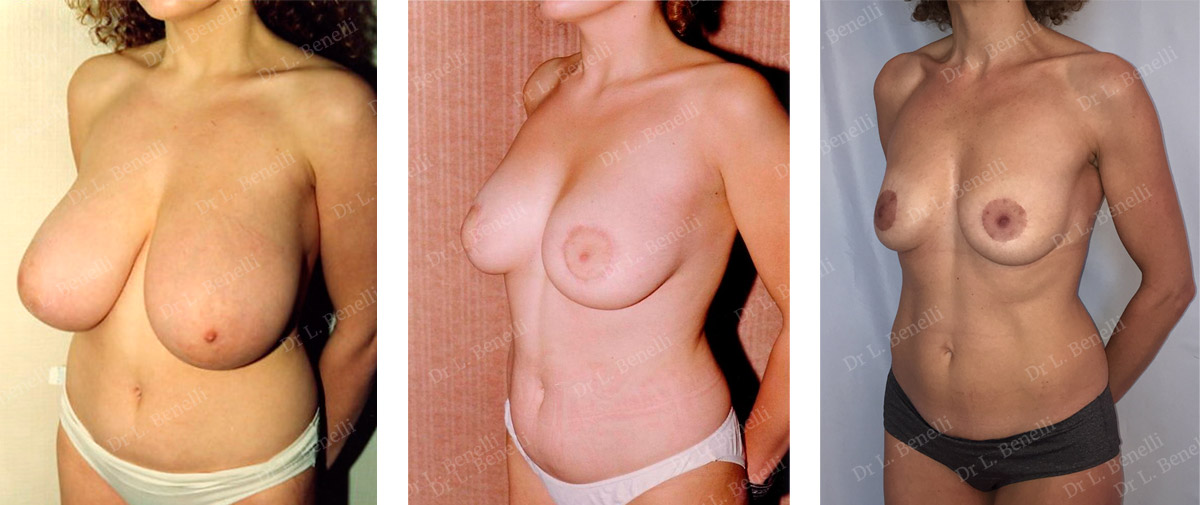
Young girl breast reduction and breast lift by Round Block - Benelli lift: Result after 6 months and 20 years after 2 pregnancies and 15 kg lose weight
If the skin and gland are very loose, a vertical scar under the areola will be needed in addition to the periareolar scar.
With this vertical scar technique, redraping much of the excess skin around the areola using the Round Block - Benelli lift technique will avoid the horizontal scar in the crease under the breast produced with standard inverted T techniques, where the excess skin is essentially redraped downwards into the crease under the breast. Combining the Round Block - Benelli lift periareolar technique with a vertical scar under the areola makes it possible to redrape all excess skin upwards into this periareolar and vertical subareolar scar without making a horizontal scar in the crease under the breast.
In cases of empty, sagging breasts, the Round Block - Benelli lift is very often used for breast lifts, to lift the areola and breast skin into a satisfactory position with a single scar around the areola. The curve of the breast is produced by simultaneously inserting a prosthesis with the desired volume.
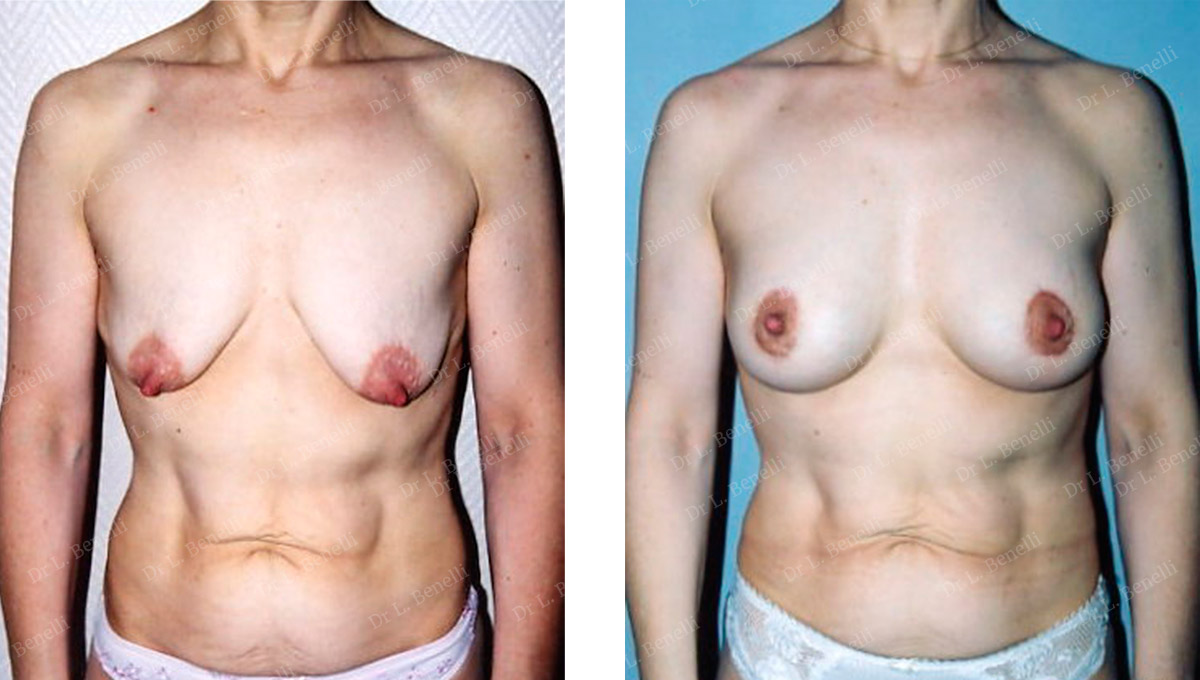
Round Block - Benelli lift Breast lift, no scar under areola voluma augmentation by implants
When sagging breasts have sufficient volume, it is not necessary to insert prostheses. The curve of the breast is created by shaping the collapsed gland into a cone.
Background
- 1983: technique developed by Dr Louis Benelli (Paris) - first surgeries.
- 1987: first medical publications giving results of 4 years of surgery.1989: first international medical publications in plastic surgery conferences, followed by widespread dissemination of the technique in other countries.
- 1990: the technique is widely adopted by the international scientific community and the subject of an entire chapter in a number of reference publications on general plastic surgery and breast plastic surgery.
- 1992 onwards: the technique is taught by Dr Benelli at many international conferences, including a 2-hour class at the US national plastic surgery conference; class repeated each year since 1992.
Use of the Round Block - Benelli lift technique across the world
Since my first publications in 1987, the Round Block - Benelli lift periareolar technique has become increasingly popular and very common worldwide, especially for treating empty, sagging breasts. In these cases, inserting a prosthesis is a simple way of improving the breast’s curve and the Round Block - Benelli lift lifts the areola and breast skin elegantly, leaving a single periareolar scar.
In cases of hypertrophy or ptosis treated without a prosthesis, remodelling the gland to give the breast its shape is more complex, specific to the patient’s anatomy, and must be carefully adapted to each case to achieve well-curved breasts with a single periareolar scar.
This very specific remodelling is very different to the kind that is based on standard cutting of the skin using pre-established patterns and inverted T scar techniques.
Because this remodelling is difficult without a prosthesis, the Round Block - Benelli lift technique is less widely used for hypertrophy and ptosis but has nevertheless steadily become more popular across the world, especially in recent years.
The photographs on this page are to illustrate and complete the information given on the operations. They are merely for information purposes so you can see the goals, results and scars from the operation.
The likelihood of scarring and each patient’s individual anatomy are different. For this reason, therefore, the photographs on this site do not commit Dr. Benelli to providing all patients with a similar result.
The information given on a site is not sufficient in itself and a medical consultation is essential to get the right information for each individual case. For this, you will need to consult a surgeon qualified in Plastic Reconstructive and Aesthetic Surgery.
